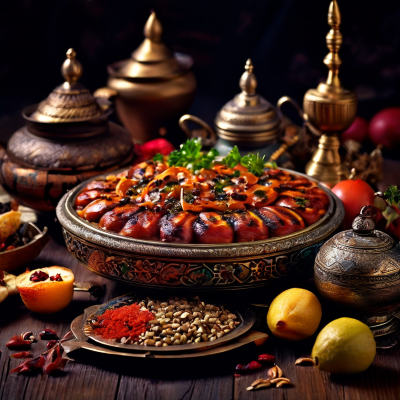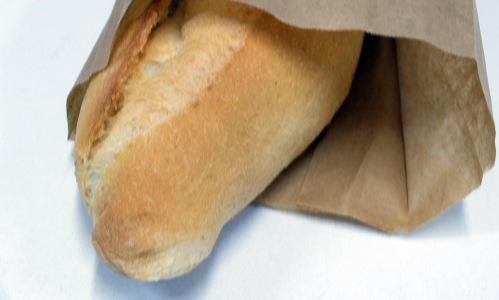Recipe for Pumpkin Pie from Maljau’t-Tabbahin (The Haven for Chefs):
“Preparation: Grease a suitable pot lid and layer five or ten thinly rolled-out dough sheets, into which oil and eggs have been added, during the kneading process. Then, layer minced lamb and finely chopped onions cooked with a little salt in a pan, and add cinnamon, pepper, peeled almonds, and pistachios, spreading them on top of the thinly rolled-out dough sheets. Cover with the remaining five to ten dough sheets, and then cover it with a suitable pan or a copper pot, cooking it by sprinkling coals both below and on top. It becomes a delicate pastry.”[1]
Taste has surpassed the confines of specific national culinary styles and achieved a universal appeal. Turkish cuisine stands out as a notable culinary tradition, alongside Mediterranean and Asian cuisines. The flavors that have gained popularity in societies remain present at significant competitions, renowned global restaurants, and households located thousands of kilometers away, much like they did in earlier times.
Unlike other creatures, humans have a rich culinary culture. Turkish cuisine first developed in Anatolia and then in Thrace and Istanbul, gradually evolving into a true culinary culture over time. In a traditional Anatolian meal, soups, meat dishes, rice or pasta varieties, pastries, olive oil dishes, salads or pickles are mainly served. A delicious table set according to the Anatolian culinary tradition, which emphasizes consuming warm and fresh food, is crowned with dessert. If the mentioned food varieties are consumed in a balanced manner, one’s daily caloric, mineral, and vitamin needs can easily be met.
The art and etiquette of cooking are different for each dish. We have all heard from our mothers, who are the classic chefs of every home, that “delicious food cannot be cooked without love accompanying the cooking process.” Patience, precision, and care are observed when cooking dishes made from seasonal vegetables and fruits, satisfying the taste buds. Marriage, circumcision ceremonies, the birth of babies, and condolences are experienced intertwined with meal tables in our traditions and customs. We multiply or reduce our unforgettable moments or sorrows by sharing them at the dining table. Expressions like “Let’s eat sweet, talk sweet” or “Eating together nurtures friendship” from our culture are mentioned in almost every home and table when appropriate.
In particular, the term “God’s guest” may be challenging for many nations to grasp its meaning. The essence of this concept is experienced almost everywhere in society, joyfully and wholeheartedly. It is called “God’s guest” because it is seen as a means to increase abundance in the house, to attain God’s good pleasure, and to the person who comes to the door, whether informed or uninformed, due to the possibility of being a means to seeking God’s approval. They are cherished, invited in, and treated with respect and generosity. The visiting guest also behaves with sensitivity, content with what is found rather than what is expected, to ensure the host’s satisfaction. How beautiful are these peculiarities of Anatolian hospitality, honor, and generosity!
In school or elsewhere, something eaten without offering to our friends does not pass down our throats and is at least offered to the person in front of us, considering it is a right for the eyes. It is already satisfying with the belief that the remaining will be blessed. In particular, the saying “One person eats while the other observes, and calamity is imminent!” is a powerful lesson we imbibe from a young age. Sharing food is appreciated in different cultures. The act of sharing food, offering before taking, is a significant practice and not to be taken lightly!
While tea services after meals have now started to be replaced by coffee, if fruit or what is called a cold serving is offered alongside, it gives the feeling that the meals, along with conversations, spread over long hours in sections of the table. Coffee, dating back to the 16th century, is not consumed only after meals. We have so many occasions to brew tea and coffee that the instruction “Make some tea, we’re coming” is like blowing the “be ready horn” at home, it gets everyone up, the place is tidied up, tea and coffee offerings are made, and guests are waited for. These sentences, heralding the excitement of sweets, are famous not only for visits in the morning and evening but also around 5:00 pm.
During the period when our people lived in nomadic communities, they primarily consumed meat-based diets. After coming to Anatolia, they lived together with people from different cultures. These coexistences led to the diversification of eating and drinking habits. Accumulations belonging to the rich Anatolian cuisine that do not compromise on fundamental dynamics, unfortunately, were not collected in a book for a long time.
Recipes were passed down orally or recorded on scraps of paper from mother to daughter, from master to apprentice, and most of them were lost in the sieve of time. Especially, works called Surnama, which narrate the marriages of the daughters of the sultans and the circumcision ceremonies of the princes, were very beneficial in this regard. We can learn the types and recipes of jams, desserts, and dishes offered at the circumcision ceremonies of Bayezid and Cihangir, the sons of Sultan Suleiman the Magnificent, from these records.[2]
Apart from Surnamas, in works called Majmua, where poems and texts on different themes are gathered, you can occasionally come across recipes for food, sherbet, or desserts. The oldest book about food is a work called Kitabu’t-Tabih (The Cookbook), written in Arabic in the 13th century and translated into Turkish in the 15th century.[3] In this book, 159 recipes are given in 11 separate sections, and later 77 more recipes were added.
After that, no cookbooks were published until the 18th century. Works such as The Rumeli Desserts[4] and The Treatise of Ağdiye[5] are two of the few works that people benefited from until the first printed cookbook was published. Just five years after Tanzimat, in 1844, The Haven for Chefs (Maljau’t-Tabbahin) was published, being the first printed cookbook and was printed by Mehmed Kamil, one of the professors of the Imperial Military School of Medicine.[6] The book, which had eight editions within 44 years, earned the title of the best-selling book of its time and, like today’s cookbooks, served as a source for cookbooks written after it. This work has performed a great duty in passing on the culinary culture accumulation from the past to the future generations. It is possible to download Maljau’t-Tabbahin from the website of the Directorate of Manuscripts.
They asked Nasreddin Hodja, “Which dish do you like the most?” He said, “Baklava and pie.” They asked Hodja again, “Which instrument do you like the most?” And he answered, “The pot and pan’s music.” The favorite instruments of the Anatolian people, such as pots, pans, forks, and spoons, continue to resonate with prayers and wishes, bringing hearts together, just as they did in the past.
Footnotes
[1] Mehmed Kâmil, Melceü’t-Tabbâhîn, Istanbul: Yazma Eserler Kurumu Başkanlığı, 2015, pp. 53–54.
[2] Günay Kut, “Kanunî’nin Oğulları Sultan Bayezit ve Sultan Cihangîr’in Sünnet Düğünlerindeki Kına Gecesi Ziyafeti”, Acâibü’l-Mahlûkât: Eski Türk Edebiyatı Araştırmaları II, İstanbul: Simurg, 2010, pp.137–141.
[3] Muhammed b.El.Kerim, Kitâbü’t Tabih Abbasi Bağdatından Yemekler, Tatlılar, Çeşniler, Giriş ve Notlar: Charles Perry. Tr. Nazlı Pişkin, İstanbul: Kitap Yayınevi, 2009.
[4] Et-Terkîbat fî Tabhi’l-Hulviyyat (Dessert Recipes), ed. Günay Kut, Ankara: Kültür ve Turizm Bakanlığı Yayınları, 1986, 44 p. + 32 p.
[5] Türk Yemekleri – XVIII. Yüzyıla Ait Bir Yemek Risalesi, Haz. M. Nejat Sefercioğlu, Ankara: Kültür ve Turizm Bakanlığı, 1985.
[6] Mehmed Kâmil, Aşçıların Sığınağı, Melceü’t-Tabbâhîn, 1. Yemek Kültürü, 2. Yemek Tarifleri, 3. Mehmed Kâmil, 4. Günay Kut, 5. Turgut Kut.




